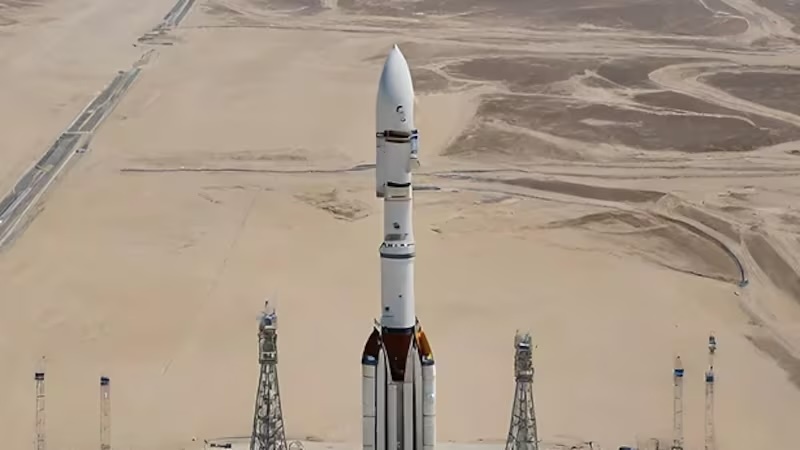21.11.2024
The launch would help Sultanate move closer to starting commercial operations of the spaceport in 2030

A rendering of the Etlaq Space Launch Complex. Photo: Nascom
Oman is preparing to carry out a maiden rocket launch from its under-construction spaceport next month, in a major boost to the region's growing ambitions in the sector. The Etlaq spaceport, being developed in the port town of Duqm, aims to support scientific and commercial launches, with operations expected to begin fully by 2030.
The National Aerospace Services Company, which is overseeing the spaceport, said it will conduct “an experimental vehicle launch” in December. However, the company did not specify a date or the type of launch vehicle involved in the operation.
Nascom said that the launch was “not a publicly accessible event” and that more information would be shared after lift-off.
“In accordance with local regulations and international safety standards, we are supporting the launch of an experimental launch vehicle before the end of 2024,” Nascom told The National.
The project is part of Oman’s efforts to diversify its economy and secure a competitive edge in the global space industry.
Experts believe the port could complement the Gulf’s growing space programme, addressing a crucial regional gap in launch infrastructure.
Ready for lift-off
Anna Hazlett, founder of space advisory firm AzurX, said that Oman’s plans for a spaceport could position the Gulf as a global space base along with the UAE and Saudi Arabia.
“Oman’s strategic location offers ideal conditions for equatorial launches, making it attractive to international partners seeking cost-effective launch solutions,” said Ms Hazlett, who played a vital role in helping Jeff Bezos’s Blue Origin assess plans on international launch sites for its New Shephard rocket.
“The Duqm spaceport also presents economic benefits for Oman. Driving high-skilled job creation in aerospace engineering, logistics, and data analytics, while encouraging foreign investment in the country’s budding space sector.” she said.
“For neighbouring countries, such as the UAE and Saudi Arabia, the spaceport represents a complementary platform for scientific collaboration and regional capacity-building efforts.”
Ms Hazlett said that Oman would also integrate itself into the global commercial supply chains once the spaceport begins operations, enhancing the Gulf’s overall influence in the space economy.
The spaceport is being designed to accommodate all sizes of launch vehicles with three complexes to launch micro, large orbital and suborbital craft.
Sahith Madara, an aerospace engineer and founder of advisory firm Bumi and Space, said that Oman has found a strategic gap in the market that sets it apart from neighbouring countries.
“Economically, this could be huge for Oman. It's not just about small or large classes of rocket launches, it involves creating an entire ecosystem for space operations, including the development of launch infrastructure, vehicle integration facilities and ground support systems,” he said.
“These developments will drive demand for skilled labour in fields like aerospace engineering, avionics, structural analysis and systems engineering.”
Supporting diversification goals
He said that for a country looking to move away from relying on oil, this was a “big opportunity”.
“It’s similar to what Kazakhstan did with the Baikonur Cosmodrome, creating partnerships and economic benefits,” he said.
“Oman needs to take notes from initiatives like these but adapt them to what works for the region. For neighbouring countries, Oman's space ambitions might trigger both collaboration and some friendly competition.
“The UAE has advanced space tech and an amazing astronaut programme, but no dedicated launch site yet. The Duqm spaceport could fill that gap and maybe even become a shared resource for the region.”
Companies such as Blue Origin and Virgin Galactic have considered the Middle East, especially the UAE, to launch their space tourism flights.
But nothing has materialised so far, with reports that US regulations – specifically the International Traffic in Arms Regulations – restrict American companies from exporting certain technology.
Nascom told The National previously that it was working towards “removing that barrier” once it starts getting interest from launch companies.
While Oman's spaceport would support traditional vertical space flights, the UAE is looking to host horizontal ones.
Radian Aerospace is developing a horizontal take-off and landing, single-stage, fully reusable spaceplane called Radian One. A prototype is being tested at a small airfield in Abu Dhabi.
The spaceplane, which can carry passengers and cargo, is designed to fly to low-Earth orbit, with the company hoping to carry out the first suborbital test flight in 2028.
If all goes according to plan, the first orbital flight will take place the following year and commercial operations will take place soon after.
While, Abu Dhabi's Mira Aerospace is developing a High-Altitude Platform Station, which operates thousands of metres above the Earth's surface to capture real-time data and provide high-speed communications from the lower part of the stratosphere.
Quelle: The National
